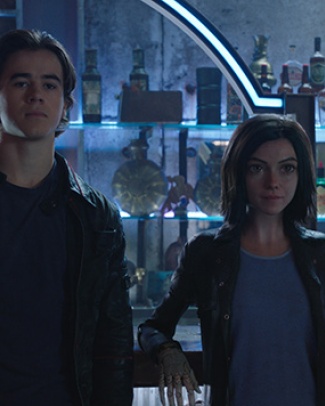Alita: Battle Angel is a bit of a mess. Or in the critical jargon, it is something of an eclectic mix. In this sense: tropes abound. From start to end, Alita is one long series of tropes that you will have seen before. It begins with with amnesiac cyborg girl who, it rapidly becomes clear, has a mysterious past in which, inter alia, she just happened to be a near unbeatable warrior (think Ghost in the Shell: think Blade Runner, but maybe not so much).
Then there's the world in which Alita (Rosa Salazar) operates, a dystopian neo-capitalism (too many to choose from), under which a down-trodden ground-living workforce are exploited by “The Factory”, while an aged snowy-haired boss controls all from inaccessible sky city Zalem (think Hunger Games...right down to our emerging heroine grieving over a love who may or may not have been lost, and vowing to get even with remote overlord, Nova).
Last but by no means least we have Motorball, the homicidal roller-skating track game (think Rollerball, lifted to a level of violence that might have given pause even to James Caan) which, in the absence of storming the sky citadel is the only means to access sky city. By being a Motorball champ.
I can't help thinking this suggests a basic flaw to the world-building here.
No-one ever goes up to Zalem. Unless they have first gone to pieces. Literally. Because there is a flourishing trade in body parts, both real and artificial, going on here. To protect yourself from rebellion you impose a no travel rule. But then you introduce a loophole that means that once every so often years you invite the fiercest, most homicidal player of Motorball into your front parlour. This can only end badly.
And unfair. Alita looks a bit like Director James Cameron scoured the last two decades of sci-fi in order to patchwork together something new-old. In fact, Alita is based on Japanese cyberpunk manga series, Gunnm by Yukito Kishiro, and is a project he began at least as early as 2000. But then other “little” projects, like Avatar, cropped up, and Alita was put back and back, until it looked like it would never see the light of day.
And in the end, while what we have here is messy and a little slow to get off the ground and a LITTLE bit cliched, we are going to be glad he did. Because there is almost certainly more Alita to follow.
In this first outing, the year is 2563, and we are 300 years on from “The Fall”, a catastrophic war that turned most of the Earth to rubble, Alita's head and cyber-heart are discovered on a scrapheap just outside the city of Zalem by cyborg scientist Dr. Dyson Ido (Christoph Waltz), who runs a clinic in which he tends, mostly free of charge, to locals who have lost limbs to various misfortune (see above: flourishing trade in body parts!).
Almost everyone is augmented in some fashion, whether through the addition of robotic arms or through full body transplant into law enforcement machines or...well, the only limits to what you may be is your imagination and what you can afford.
Drawn to this lost and – initially – amnesiac cyborg, Ido attaches her head to a body he happens to have lying around (one he built for his daughter, Alita, some years before). And yes: that identity with his now-deceased daughter is every bit as creepy and disturbing as it sounds. And then we're off on a predictably dystopian arc, as Alita quickly discovers hidden warrior skills, establishes herself within the local Hunter-Warrior community (mercenaries who make a living from hunting down local criminals) while falling in love with pretty but otherwise feckless young lad Hugo (Keean Johnson).
Along the way, Alita gets involved in playing Motorball – we know this will happen as one of the first things Ido tells her is: do not get involved with Motorball. And comes to the attention of local baddies Vector ( Mahershala Ali) and Chiren (Jennifer Connolly), who in turn report to the big boss in the sky, Nova (Edward Norton).
Much battling later, the decks are cleared. Many of the minor characters have been removed from the board,,,and the film ends on a promise of more action to come when Alita finally comes face to face with Nova – which we guess will take place in the second movie in this franchise.
Somewhere hovering in the background is the suspicion that not only Alita, but also Nova have unfinished business between them. For Alita certainly is the last remnant of the Fall – and we know little about Nova except that he is, for all practical purposes, immortal. Ooer!
So yes. This film is flawed. But once it settles down it holds your attention and delivers not just the usual cgi battling but an interaction between human and non-human that has not been well put on screen before. For those interested in the techies – and bear in mind that Cameron, as director, has a reputation for pushing the boundaries where film tech is concerned – Alita has received much praise for overcoming the “uncanny valley”.
This is the phenomenon according to which the more realistic a human simulation like an android or CG character becomes, the more we notice the small differences. Alita on screen is not human – check out, as everyone has – her eyes. And yet her relationship with Hugo is believable, at the physical level at least, in a way that such relationships rarely are.
So forget the mess. Accept that James Cameron has done it again and go out and enjoy yourselves with the newest sci-fi fantasy franchise.
Three and a half stars.


